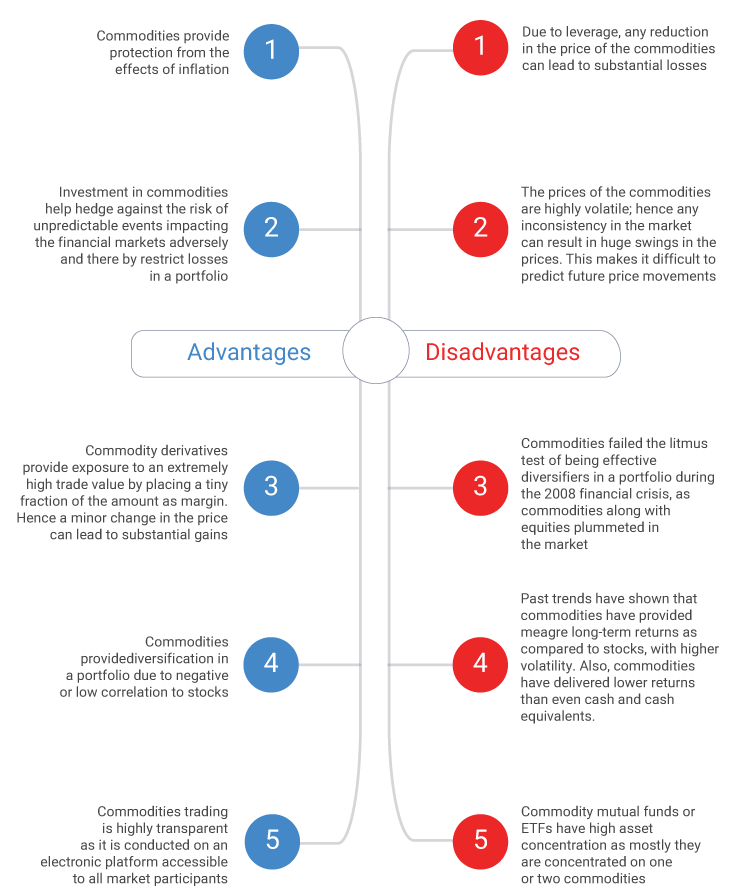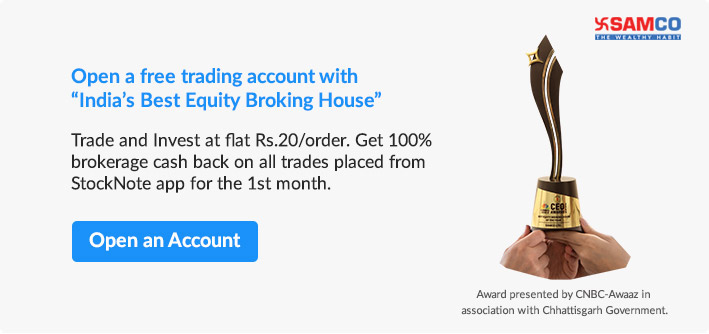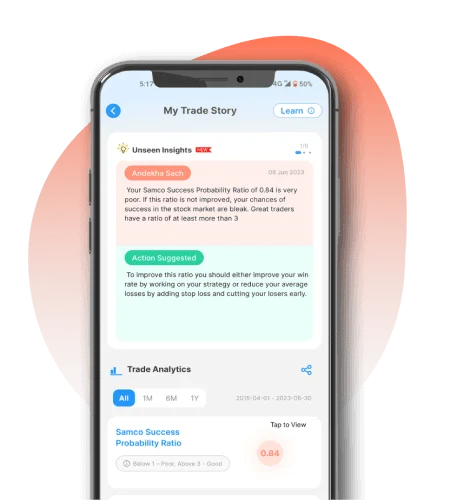Advantages of commodity trading
There are many advantages of trading in commodities. Let us understand those in detail with examples.
- Protection against inflation
As the demand for goods and services rise, it leads to an increase in the price of the goods and services as the cost of the raw materials i.e. commodity increases.
In such an inflationary environment, interest rates rise, which increases the cost of borrowing and subsequently, reduces the net income of the company. A decline in the income of the company also affects the profits shared with the shareholders.
Therefore, during inflation, the prices of the stocks fall. In contrast, the prices of commodities required in the manufacturing of finished goods substantially rise due to the growing demand, ultimately resulting in the rising prices of the final goods.
Hence, investors flee to commodity futures to protect their capital from the effects of inflation and maintain their value.
- Hedge against risky geopolitical events
Geopolitical events such as conflicts, riots and wars disrupt the supply chain which leads to scarcity of resources, as it becomes difficult to procure and transport raw material to the factories where they are converted into finished goods.
In such a case, the supply of the raw materials gets affected, which results in a mismatch of demand and supply, causing the prices of the commodities to rise exponentially.
During such events there is pessimism in the market causing the stock prices to fall drastically. Hence, investing in commodities can help stem losses in an investment portfolio.
- High leverage facility
Commodity derivatives like futures and options provide an exceptionally high degree of leverage.You can control a big position by paying only 5% to 10% of the contract value as upfront margin.
Any insignificant move in the prices of the commodities can result in exponential gains. Hence, you create the possibility of humongous returns by using leverage in commodity trading.
The minimum margin for commodity futures may vary but is much lower than stocks. E.g., you need to place only 23% of the total value of trade as initial margin for wheat futures.
- Diversification
Commodities have negative or low correlation with stocks. Commodities are usually raw materials required to make the finished goods.
Rising commodity prices increase the cost of production, which reduces the profits, leaving very little for shareholders and reducing the earnings per share.This ultimately leads to a decline in the prices of the stocks.
Also, due to inflation, the present value of future cash flows paid by stocks declines because future cash will be able to buy lesser goods and services than they would buy today. The prices of the stocks drop to reflect this reduction in value.
Hence, stocks do well when the rate of inflation is stable or slowing. However, commodities perform better when the rate of inflation is rising.
E.g., If oil prices increase, the cost of owning a car also increases, which results in declining car sales. Therefore, the prices of auto stocks also fall. Similarly, when metal prices rise, the cost of building houses increases, thus reducing the demand for real estate, which reflects in the falling prices of real estate stocks.
Hence, due to this negative correlation where an increase in the price of commodities drives the stock prices down, the losses incurred in stocks can be adjusted against the gains attained by commodity derivatives. Thus, adding commodities provides diversification to your portfolio.
Commodities respond to fundamental factors like weather, strikes, geopolitical instability, which affects the supply and demand of commodities.
However, stocks or bonds do not respond to fundamental factors in the same manner. Hence, the movement in the prices of commodities is independent of the movement in the prices of stocks.
This negative or low correlation with stocks makes commodities an enticing investment to achieve diversification in a portfolio.
Watch this video to learn how tracking commodity markets can help you make profits in equities.

- Transparency
Compared to the outcry system in the past, trades in commodities are now conducted on an electronic trading platform accessible to all market participants.
The electronic trading platform helps in fair price discovery enabled by broad-scale participation without the intervention of the buyer and seller. The price determination is driven by supply and demand, eliminating the risk of any form of manipulation.
The price discovery happens when the price and quantity quoted by the seller and buyer matches perfectly. During the entire trade, the buyer and seller remain anonymous, thus enabling a transparent price discovery without any scope for manipulation.
Disadvantages of trading in commodities
Though the advantages makes commodities an attractive investment opportunity, you must also be aware of its drawbacks to help take a calculated decision whether to trade in commodities or not:
- Leverage
Leverage can be a double-edged sword. Leverage, as we discussed earlier, helps you control a big position with little upfront capital.
So if the initial margin requirement is 5%, then you can buy commodity futures worth Rs 1,00,000 with only Rs 5,000. Even a minor change in the price of the contract can have a massive impact on your gains or losses.
So if the price falls by merely Rs 10, you can end up losing Rs 10,000, considering the lot size is 100, and 1,000 contracts have been purchased. Also, low margin requirements encourage excessive risk, which can wipe out your entire investment.
- Volatility
The prices of commodities are highly volatile and depend on demand and supply factors. The supply and demand of commodities are price inelastic.
Price inelasticity means that while the price increases or decreases, the supply of the commodity remains unchanged. For example, increasing commodity production by growing new crops, extracting natural gas from underground, extracting iron from deposits of iron ores etc takes, copious amounts of time.
At the same time, since commodities are prerequisites of daily lives, price changes will not affect their demand as they are essential commodities, and consumers are habituated to them, preventing them from looking for alternate means.
E.g., shifting to electric cars or fuel-efficient cars from vehicles running on petrol or diesel is not economical or feasible in the short term. Turning to renewable sources of energy for electricity like solar power from non-renewable sources of energy like coal-fired electricity takes considerable time.
Hence the cumulative inelastic demand and inelastic supply lead to a situation where a slight shift in market fundamentals can generate large swings in the prices.
This kind of sluggish response to demand and supply means supply and demand shocks like adverse natural disasters or inconsistent rainfall can have a huge impact on the prices of these commodities. This makes, commodities highly vulnerable to anomalies resulting in highly volatile financial instruments based on these commodities.
- Not ideal for diversification
The common consensus is that there is a negative or low correlation between the prices of commodities and the prices of stocks. As explained earlier, when the prices of the stocks are tumbling, the prices of commodities should go skywards.
However, this assumption or theory did not hold true during the 2008 Global Financial Crisis when along with the stocks, even the prices of commodities like oil and gas fell drastically. During the 2008 financial crisis, there was a fall in the overall demand, which led to unemployment.
Unemployment and reduced demand halted major production; this ultimately led to lower energy consumption. Also, the tightening of credit facilities led to the unavailability of cash or financial resources with which to make purchases, which led to lower corporate earnings and layoffs and increased unemployment, furthering the contraction in demand and pushing the oil and gas prices further down.
Oil prices during this crisis fell from a high of Rs 10840 per barrel in July 2008 to a dismal low of Rs 2433 per barrel in February 2009, while LNG prices fell from Rs 1032 to Rs 300. Thus the 2008 Global Financial crisis is a case in point that commodities may not be effective for portfolio diversification.
The main reason why investors add commodities to the portfolio is because of the negative correlation between stocks and commodities. But from 1991-2017, the correlation of stocks to commodities was 0.30, while the correlation of stocks to Treasury Bills was 0.40. During the same period as we will see below commodities have produced lower returns than treasury bills.
This means cash has provided better returns than commodities with far lesser volatility, and with somewhat similar correlation to stocks. Hence, commodities may not be the ideal candidate for diversification of a portfolio majorly consisting of equities.
- Lower returns with higher volatility:
Performance Statistics 1991-2017
Bloomberg commodities Index S&P 500 Index One Month Treasury Bills Annual Returns 2.18% 9.93% 2.61% Volatility 14.68% 14.17% 0.62% The Bloomberg Commodities Index can be considered as the barometer of the performance of commodities over time.
As can be seen in the table, one-month Treasury bills which is the most risk-free asset in the financial universe, has provided more returns than commodities since 1991. Stocks have produced far significant and outsized returns compared to commodities at lesser volatility.
However, the explosive volatility suggests that this asset class goes through frequent periods of booms and bust, which provides a lucrative opportunity for traders and speculators.
The drawback of this cyclical nature of commodities is it entices long-term investors who are mesmerised by the size of short-term gains. However, as the table suggests such returns are always given back while at the same time eroding the value of the investment.
Hence, for the long-term, buy-and-hold investor or the followers of the legendary investor Warren Buffet, it’s a territory one must practise caution.
- Asset concentration
While diversification may be one of the reasons to include commodities in a portfolio, the commodity funds themselves are concentrated in 1 or 2 industries and hence are non-diversified. As a result, a change in the price of a commodity can have a substantial impact on the share price of a commodity ETF.
Advantages & Disadvantages of Commodity Trading - A snapshot

With all its advantages and disadvantages, commodity trading is still the best way to diversify your investment portfolio and hedge against adverse stock market movements.
[Suggested Reading: Tips for Commodity Trading in India]
Commodity trading through futures and options is a lucrative investment avenue which can help you create abundant wealth. You can open the best commodity trading account in India with Samco in just 5 minutes and get started!

By Deepika
KhudeDeepika
Khude
The author is a Certified Financial Planner (CFP) with 5 years
experience in Investment Advisory and Financial Planning. Her strength lies in
simplifying complex financial concepts with real life stories and analogies. Her goal
is to make common retail investors financially smart and
independent., Samco.in | Last Updated: Jun 21, 2022









 Easy & quick
Easy & quick